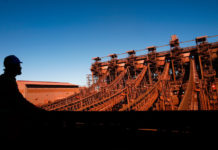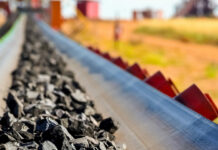
DUNCAN Wanblad, CEO of Anglo American said today he had no illusions about the task of restoring Transnet’s capability on its critical Sishen to Saldanha iron ore line.
Commenting on the downgrade of Kumba Iron Ore’s production forecasts for 2023 and 2024, which were a consequence of Transnet constraints on the route, Wanblad called on investors to be “realistic” about how long it would take.
Kumba earlier announced that production over the next two years would be well below its 41 million tons (Mt) to 43Mt levels previously forecast. “I think we will slowly make progress to get back to that level,” he told investors at Anglo’s investor update today.
“But we have to be realistic in terms of thinking about how long it may take us to do that, and what the road will look like to get there. So I’m still slightly optimistic that these are viable ambitions for us to have,” he said.
Wanblad made an unscheduled visit to South Africa in September in order to meet with officials from the Department of Public Enterprises and Transnet to discuss the utility’s ongoing problems. “We provided a lot of input and offered our assistance and offered all sorts of potential solutions,” he said today.
Kumba also announced an indefinite delay in the implementation of a project it previously dubbed “a game changer”, citing “complexities” building it.
The construction of the ultra high dense media separation (UHDMS) plant aims to reduce waste material, effectively extracting more iron ore per ton of rock mined. However, “additional complexities” to do with the conversion of the existing processing plant means the UHDMS project won’t be ready this year as previously planned, the company said.
“The review includes work to obtain clarity on the full extent of the impact on the overall project schedule,” Kumba said, adding that it remained confident in the “overall” project.
The project was “robust”, said Wanblad. He added: “I’m very certain I want to potentially go ahead with this, but I want to go ahead with a new set of information … so we know how its going to end”.
The project delay was one of several hiccups for the company. It also said today the R3.6bn Kapstevel expansion, which is intended to extend the life of its flagship Sishen Iron Ore mine to 2039, would deliver first ore in the first quarter of 2024 instead of the second half of next year, as previously planned. This followed “a safety reset” earlier in the year.
Production stockpiles building
Commenting on its ongoing difficulties with Transnet, which experienced a 12 day strike in October and undertook an extended maintenance programme, Kumba said “ongoing operational challenges resulted in lower throughput than expected” for this year.
Given that the rail constraints had been in place for the most part of the financial year, there had been a substantial build up of iron ore production at its mines. As a result, production for the year would be 37Mt compared to guidance of 38Mt to 40Mt.
Sale guidance at some 36Mt to 37Mt was unchanged.
However, in order to reduce on-mine stockpiles production guidance for 2023 was reduced to between 35Mt and 37Mt from a previous forecast of 39Mt to 41Mt. Unit cost guidance is unchanged year-on-year in 2023 at $44 per ton as Kumba expected diesel prices fell amid currency depreciation.
“Our focus in 2023 is to reduce the high levels of iron ore stocks and rebalance the value chain to ensure stable and resilient operational performance as well as improved finished stock levels at Saldanha Port to facilitate our sales guidance of 37Mt to 39Mt,” Kumba said.
It added that the performance on the rail route was “expected to step up”, owing to improvements in operating conditions such as the removal on speed restrictions and the implementation of weather related mitigations. Transnet’s customers would also benefit from the purchase additional trains.
As a result, production was anticipated to be between 37Mt and 39Mt in 2024 (still lower than the previously guided 41Mt to 43Mt) while 2025 production would be between 39Mt and 41Mt.
Wanblad said that Kumba’s forecast production numbers were “fundamentally constrained by where we think Transnet might end up”. He added that the Sishen to Saldanha railway line was “the lifeline” and that there was “quite a lot of work to get it back to 41Mt to 43Mt capability”.
“It’s not impossible to do. That line is there and it’s operated there (at 41-43Mt a year) before and some work that needs to be done,” he said.










